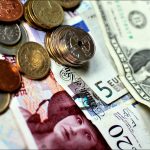- Home /
- Live Rates /
- USD/CHF
Last Updated: Jul 04, 2025 03:05:54 PM (GMT)
USD/CHF: The current market price is at 0.79871, reflecting a 0% change from the previous close. Today's economic event regarding the Swiss unemployment rate is expected to remain at 2.7%, which may have minimal impact on the analysis. Support and Resistance Levels Current support levels are 0.79444, 0.79349, and 0.79242, while resistance levels are 0.79972, 0.80015, and 0.80100. The pivot point is at 0.79717. Indicators The RSI is at 45.6, indicating neutral momentum. The ATR is 0.00098, suggesting low volatility, and the ADX is at 31.33, pointing to a strong trend. The 50-day SMA is at 0.79532, while the 200-day EMA stands at 0.79383, showing a slight upward trend. The Parabolic SAR is at 0.79827, signaling a potential price reversal. Market Sentiment The market price is above the pivot point (0.79717), suggesting a bullish trend supported by the strong ADX and upward SMAs.
USD/CHF Signals & Technical Analysis
Market Sentiment
Trend Indicators
Oscillators
Moving Averages
Pivot
About the USD/CHF (US Dollar/ Swiss Franc)
Breaking Down ‘USD/CHF’
The USD/CHF is one of the most traditionally traded currency pairs on the forex market. The CH stands for ‘Confoederatio Helvetica.’ This is Latin for Switzerland. While the F stands for Franc. What makes this currency pair so appealing?Two interesting factors:
The Greenback is the world’s largest and most actively traded currency. In fact, it represents approximately half the trading volume of all major currencies. The Swiss franc is popular because Switzerland contains an impressive one-third of the world’s privately owned wealth in its banks. It’s also worth knowing that Switzerland is not the only nation to use the Swiss franc. Liechtenstein, located between Switzerland and Austria and consisting of just 35,000 citizens, has also adopted the Swiss franc.What Determines the USD/CHF Exchange Rate?
Several factors can impact the USD/CHF valuation, including: SNB & US FED Monetary Policies: The Swiss National Bank and the Federal Reserve control the supply of money in the market, to keep the economy on track. A dovish policy, which is also known as expansionary policy, weakens the currency. In contrast, a hawkish monetary policy (contractionary policy) strengthens the corresponding currency. Economic Events: Any movement in the US and Swiss economic events determines the exchange rates. Top of the line economic events include GDP, Employment Change, Industrial Production, and Consumer Price Index. Better than forecast data increases the demand for related currency and impacts the value of either CHF or the US Dollar, causing fluctuations in the USD/CHF exchange rate.Correlated Currencies
Of the major currency pairs, the USD/JPY and the EUR/USD bear the highest correlation with the USD/CHF. The USD/JPY has a one-year correlation of 0.83 with the USD/CHF, and the EUR/USD has a one-year inverse relationship with the USD/CHF of -0.96. Some of the less prominent currency pairs that are highly correlated with the USD/CHF, include: EUR/HKD (-0.96), CHF/HKD (-1.00), HKD/JPY (0.83), USD/CZK (0.93), USD/DKK (0.96), USD/HUF (0.91), USD/SEK (0.88), and USD/SGD (0.89). Although gold is not a currency by definition, it is often viewed as and traded in the same way as currencies, especially in the modern electronic trading environment. The Swiss Franc is highly correlated with gold; hence, the USD/CHF and XAU/USD (Gold/United States dollar) have a remarkable one-year inverse correlation of -0.82). When the USD/CHF pair moves higher, gold tends to move lower.Major Economic Events:
Gross Domestic Product – the Gross domestic product is the central measure of economic growth in the region. Employment Change – The Swiss Franc is sensitive to changes in employment, as slacks in the labor market cause a drop in Inflation rates. Consumer Price Index – Since one of the goals of the SNB is to maintain price stability, they keep an eye on inflation indicators such as the CPI. If the annual CPI deviates from the central bank target, the SNB could make use of its monetary policy tools to keep inflation in check. Trade Balance – The Swiss economy is massively export dependent. Falling export numbers could lead to a decline in economic activity. Retail sales – The headline retail sales report measures the monthly change in the total value of sales at a retail level.USD/CHF Specifications
The USD/CHF is traded in amounts denominated in the Swiss Franc. Standard lot Size: 100,000 Mini lot size: 10,000 One pip in decimals 0.0001 Pip Value: $10 (varies with exchange rate)Formula
Profit/Loss = (Bid Price – Ask Price) X Contract Size X Number of Lots / Closing PriceUSD/CHF is a popular currency pair for traders to consider. It is a major pair, meaning it generally has higher liquidity and tighter spreads than other pairs. The main factors influencing the movement of EUR/JPY are economic growth, central bank interest rate decisions, geopolitical events, and global risk sentiment. Generally speaking, if Eurozone economies are performing well and the ECB (European Central Bank) is signalling an interest rate hike then the EUR/JPY pair will tend to rise in value as investors buy into it due to the expectation of better returns from a higher rate environment. On the other hand, if geopolitical tensions rise or risk sentiment weakens then it could cause investors to sell off their EUR positions causing it to fall in value compared to JPY.
USD/CHF is currently experiencing bullish sentiments. This means that the US Dollar is expected to appreciate against the Swiss Franc, resulting in a higher exchange rate of USD/CHF than before. Factors such as an increase in demand for the US Dollar due to its stability compared to other major currencies can cause this appreciation which drives up the price of USD/CHF.
The US Dollar (USD) has seen mixed results against the Swiss Franc (CHF). On one hand, recent economic data from the U.S. has been showing signs of strength and optimism which could lead to increased demand for the USD, leading to a potential appreciation against CHF. On the other hand, however, geopolitical turmoil in Europe and Brexit talks have caused uncertainty in global markets and reduced investor confidence which may lead to bearish sentiment pressuring the USD lower versus CHF.
The USD/CHF currency pair is affected by a number of factors that can influence the relative value of each currency. These include:
1. The overall strength of the U.S. dollar (USD) compared to other currencies, including the Swiss franc (CHF). This is influenced by economic data such as trade balances, inflation rates, employment figures and interest rates set by the central banks of both countries.
2. The overall strength of the CHF vis-a-vis other currencies, which will be similarly influenced by economic data related to Switzerland such as their trade balance and interest rate setting decisions made by their central bank (Swiss National Bank).
3. The specific relationship between the USD and CHF themselves - this may be affected more directly due to exchange levels or capital flows between both countries that lead to higher demand for one currency over another at any given time in particular markets or exchanges.
Sidebar rates
- <% signal.pair %>




